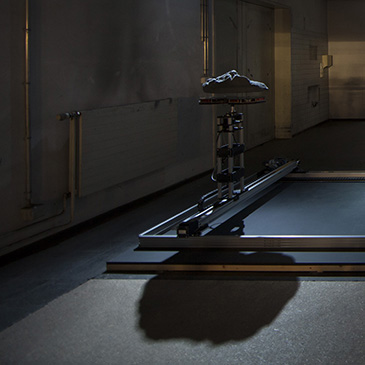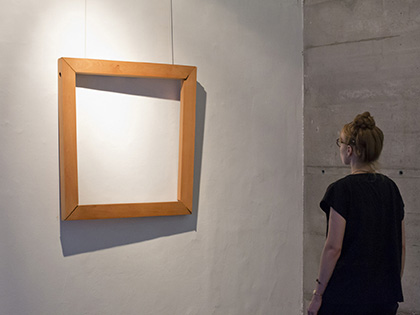ARS ELECTRONICA 2015
by Dominique Moulon [ September 2015 ]
The Ars Electronica Festival in Linz, Austria, has been focusing on the relationship between the arts and technology since 1979. For this 2015 edition, researchers have devised together tomorrow's housing while artists, like every year, presented works that are rooted in our contemporary societies.

A music of sounds
 T
The public of the
Offenes Kulturhaus is welcomed, as it should be, by a mediator. But it offers to those who wish, to part with an object, by reducing it to nothing under the strong pressure of a massive hydraulic press. What’s to stop you from compressing your smartphone, this object that too frequently blurs our spirits, even pervading artistic contexts? The spectator who has actively participated in the destruction of the object of their choice will walk away with an audio file, that of a music of sounds corresponding to the grinding skilfully stretched in duration by the apparatus called "Oil" and designed by the Russian artist Dmitry Morozov aka
::Vtol::. The object will have been sacrificed and converted into a work of immateriality where the noise is elevated to the level of music as Luigi Russolo already envisaged in 1913 in a letter that would become a manifesto (L'arte dei Rumori) where he stated: “To excite and exalt our sensibilities, music developed towards the most complex polyphony and the maximum variety, seeking the most complicated successions of dissonant chords and vaguely preparing the creation of musical noise.”

Hybridization between media
Alex Verhaest,
“ Temps Mort /
Idle Times”, 2014,
Courtesy
Grimm Gallery.
 I
In Linz, in September, awards are presented and the Golden Nica in Computer Animation went this year to the Brussels artist
Alex Verhaest. A light borrowed from the primitive paintings of northern Europe gives an atmosphere of unity to the works of his series "Temps Mort / Idle Times". The few insects that come alive betray the video in his still lives, as micromotion extirpates his portraits from the photographic. The analysis of these few pieces brings us many clues for deciphering the group video that the viewer can "call" on the phone. Drawn from their silence, they alternately express themselves without a real dialogue ever beginning. In essence, those who live the image of this family, for which the public has to gage the seriousness of the situation that has brought them together, have a dual presence. This has the effect of complicating the reading of the scene where everyone expresses in his or her own way the absence of whoever is not in the picture.

Art and Science
ARTSAT1:Invader,
“Art and Satellite Project ”,
2014-2015.
 A
Among the most coveted prizes, there is the Golden Nica in Hybrid Art, which as a sign of the times, has gradually replaced interactive art because there is nothing in this world that has not been hybridized in some way in recent decades. This is about relationships, however historical, that the arts maintain with science, particularly through the Japanese project "
Artsat1", which was initiated on February 28, 2014 by the launch of a satellite that is qualified as artistic. This latter, in the shape of a 10 centimetre cube, is connected to the object presented to us in the space of the exhibition and that we are invited to touch, because its temperature is that of its double, moving at an altitude of 378 km. It is a sculpture that we feel, communicating to us the warmth of a distant celestial body that encourages us to reconsider our position in the universe. By touching this tangible object, our perception appears to us as infinitely stretched.

Portrait
Christa Sommerer
& Laurent Mignonneau,
“Portrait on the Fly”, 2015.
 A
At the crossroads of art and science in Linz, there is the Ars Electronica Centre. It is here that the pieces of the "Portrait on the Fly" series by
Christa Sommerer & Laurent Mignonneau are presented. Generative, sequential or fixed, all revolve around the same idea, as it is thousands of flies that are always at work. It is as if the model attracted them because they mass together to tirelessly draw up portraits. The slightest movement causes them to reconsider their relationship to the group as portraits are made and lost over time. In order to fix the postures in time, the artists have opted for the use of a plotter in a similar operation to those used by the pioneers of computer art. It was in the 1960s when the art market had only recently become interested in plotter drawings of the time. The perennity of the still portraits of the series "Portrait on the Fly" will inevitably interest art collectors, as it is the decidedly ephemeral appearance of the interactive installation of the two artists that intrigues festival spectators.

Enhancing installations
Pablo Valbuena,
“Time tiling [post]”, 2015.
 T
The two artistic directors of the Ars Electronica festival, Gerfried Stocker and Christine Schöpf, decided this year to make use of the Postal Sorting Station of Linz to reveal to us its strangeness, between excess and obsolescence. So what is more natural than to have given fragments of walls and floors to
Pablo Valbuena, who has a talent for enhancing the harmony of tile or brick installations with light. Equipped with video projectors, he redraws the forms of architectural finishings through his interventions in the series of "Time Tilings". By whitening the height and width or the diagonal lines, he converts the planes over time. Animating the lines with a pure light that he projects on the interiors of the Postal Sorting Station, he reveals a form of beauty that goes well beyond that of this place steeped in history to the universal, and harmonised. To the radicalism of the grids, he contrasts an endless transition period so that we do not know the exact nature of what we observe. Though his writing may cling to the lines of our immediate surroundings, it never ceases to free itself to better stimulate our imaginations.

The art of memory
Felix Luque & Inigo Bilbao,
“Memory Lane”,
2015.
 C
Close to Pablo Valbuena’s projections, there is a piece by
Felix Luque &
Inigo Bilbao that revolves around the memory of one of the places they shared together during childhood. The piece entitled "Memory Lane" features a stone that appears to us as if suspended in space. In fact it is and moves above an area according to the coordinates that the mechanism communicates to it. The large stone before us is like that of one somewhere else, while there seems to be nothing random about its movements. Did not Francis A. Yates, in his book dedicated to "The Art of the Memory" (1966) teach us that, "an orderly disposition is essential for good memory"? But the fact that the stone is suspended above the mechanism that causes it to move seems to extract it from the reality of the exhibition. And one cannot help thinking of the rock that completely cuts out the sky in "Château des Pyrénées" (1959) by Magritte. It makes us wonder what this suspended stone and its so perfectly ordered coordinates might contain.

Beyond the frame
Samuel Bianchini
& Didier Bouchon,
“Hors Cadre”,
2014-2015.
 E
Every year, an art school is invited by the Linz Kunstuniversität to present the work of its teachers and students, along with other artists. This year the University of Paris 8 accepted the invitation, whose historical attachment to the relationship between art and technology is well known. There we discover notably the installation "Hors Cadre" (Out of the Frame) by
Samuel Bianchini and Didier Bouchon. There are artists who, like Orlan in the 1960s, tried to climb "out of the frame", while the work shown here functions like that. But "Hors Cadre" appears to us as incomplete because it lacks the essential: the viewer. The very one which, according to Marcel Duchamp, makes the work what it is. By approaching it to contemplate the "emptiness", as it oversees nothing but a piece of the wall space of the exhibition, we activate it. From a distance, we become the model that the artist however, no longer expected. Temporarily, we supplement the installation that others also activate as we create a work by performing it.

Written by Dominique Moulon for Art Press and translated by Geoffrey Finch, September 2015.
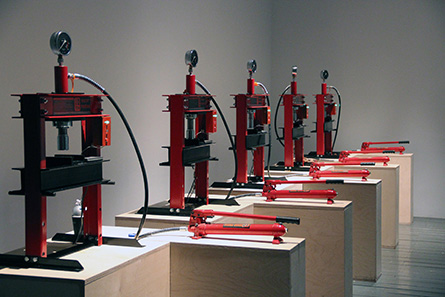
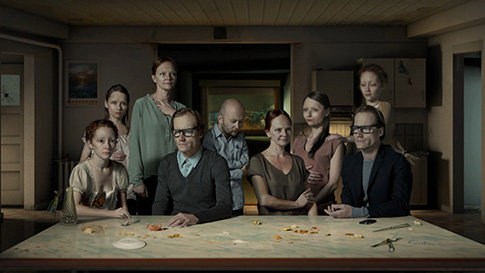
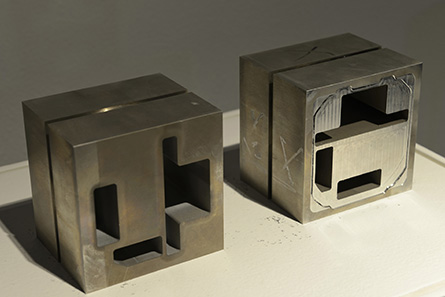
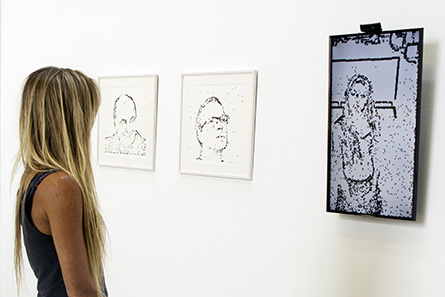
![Time tiling [post]](IM_ars15/ars15_05.jpg)
